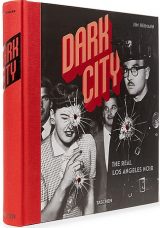With Dark City a very unusual portrait of an American city is now available. It impresses with many pictures of the city of angels that show the really shadowy sides, the ones that inhabitants from the early 1910s until the 1950s experienced, and that provided the soil and inspiration for many novels and movies.
 As locations such as Central Avenue, Mulholland Drive, Bunker Hill and Sunset Boulevard attracted not only law-abiding citizens, but also thousands of crooks, con men, petty thieves, drug peddlers and dropouts as the small city doubled and tripled its size and population after the 1920s.
As locations such as Central Avenue, Mulholland Drive, Bunker Hill and Sunset Boulevard attracted not only law-abiding citizens, but also thousands of crooks, con men, petty thieves, drug peddlers and dropouts as the small city doubled and tripled its size and population after the 1920s.
Furthermore, Los Angeles and its suburbs continuously changed the landscape as it grew in size, the model of a monster that steadily ate up land and, in a sense, people too. A fast-growing metropolis without a tradition or past that literally grew wildly. There was no equivalent to L.A. anywhere in the world.
The unbearable clash of brutal gang murders, criminal mayhem, horrific mutilations and sexual offenses and the beautiful (if wild and mixed) architecture, the mountains, the seaside and mild climate made it both a dream – Hollywood was not far away – and a nightmare. Countless bars, brothels, and later racetracks, boxing rings, casino ships off the coast, and the city’s closeness to Tijuana attracted all kinds of hoodlums.
In the middle of it: the police force, namely the notorious Los Angeles Police Department and the Los Angeles Sheriff’s Bureau, known for their brutal and corrupt workforce that was involved in committing and covering up crime on a larger scale.
The city of Los Angeles also thereby became a major actor/character in many hard-boiled novels of the 1940s and 1950s. Raymond Chandler and James M. Cain, to name but two authors, made it the location of their novels. Some of those later become the scripts for film noir classics, shot right on location in L. A.
 For that reason Heimann’s book has an appendix spotlighting some of the most prominent crime novels and movies in this context: L.A. Confidential, The Big Sleep, Mildred Pierce, The Black Dahlia, Sunset Boulevard, Chinatown and others. What additionally promoted the image of the city as a hellhole and offered a blend of fiction, speculation, Hollywood rumor and truth, were famous L.A. tabloids such as Hush Hush and Confidential, a replica of each is included here. The book also features several vintage magazine reprints (in original size) of True Detective, Look, Click, and Official Detective Stories magazine.
For that reason Heimann’s book has an appendix spotlighting some of the most prominent crime novels and movies in this context: L.A. Confidential, The Big Sleep, Mildred Pierce, The Black Dahlia, Sunset Boulevard, Chinatown and others. What additionally promoted the image of the city as a hellhole and offered a blend of fiction, speculation, Hollywood rumor and truth, were famous L.A. tabloids such as Hush Hush and Confidential, a replica of each is included here. The book also features several vintage magazine reprints (in original size) of True Detective, Look, Click, and Official Detective Stories magazine.
 Besides that, hundreds of full-scale pictures from original crime scene police photographs to magazine clippings, newspaper articles, and glossy celeb stills illustrate the uniquely dark past of this very special American city. Tough press scribes such as Aggie Underwood, city editor of the Los Angeles Herald-Express back then contributed both stories and pictures to uncover at least parts of the crime, corruption, blackmail, assaults, prostitution and anything else the many organized crime outfits would try to conceal. Legendary L. A. press photographers such as George Watson, Paul Dorsey, and Perry Fowler shot some of the grim and most real pictures here.
Besides that, hundreds of full-scale pictures from original crime scene police photographs to magazine clippings, newspaper articles, and glossy celeb stills illustrate the uniquely dark past of this very special American city. Tough press scribes such as Aggie Underwood, city editor of the Los Angeles Herald-Express back then contributed both stories and pictures to uncover at least parts of the crime, corruption, blackmail, assaults, prostitution and anything else the many organized crime outfits would try to conceal. Legendary L. A. press photographers such as George Watson, Paul Dorsey, and Perry Fowler shot some of the grim and most real pictures here.
 However, there is barely editorial text here, the black-and-white pictures predominate this publication as it is a very visual story of the dark Los Angeles. Not only fans of crime fiction and film noir will enjoy this treasure, as it convincingly shows a nightmarish side of 1940’s America.
However, there is barely editorial text here, the black-and-white pictures predominate this publication as it is a very visual story of the dark Los Angeles. Not only fans of crime fiction and film noir will enjoy this treasure, as it convincingly shows a nightmarish side of 1940’s America.
The volume comes in a cardboard slipcase with die-cut bullet holes and is a multilingual edition with all texts in English, French and German, it all weighs more than six pounds. Author Jim Heimann has already produced several parts of Taschen‘s “All American Ads” series over the years, as well as another book on L.A. (Los Angeles, Portrait of a City).
Review by Dr. A. Ebert © 2018
Jim Heimann. Dark City. The Real Los Angeles Noir. Taschen, 2018, 480 p., ISBN 978-3-8365-6076-4.
